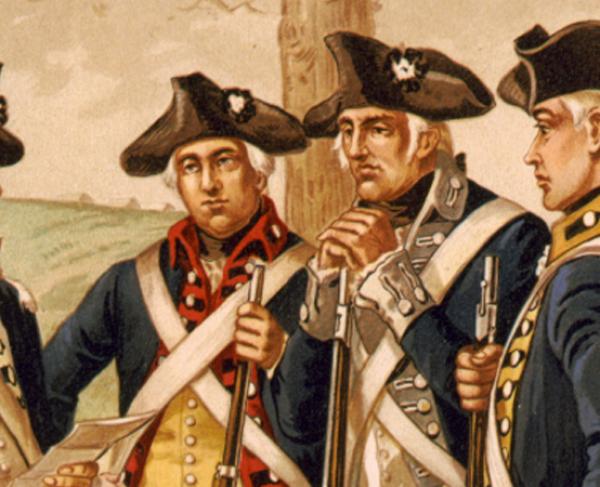
John Cadwalader and Elizabeth Lloyd Cadwalader and their Daughter Anne (1772) by Charles Willson Peale
Son of Philadelphia doctor Thomas Cadwalader and his wife Hannah, John Cadwalader was born in 1742 in Trenton, New Jersey. At eight years old, young John and his family moved to his father’s hometown of Philadelphia. John and his younger brother, Lambert, had originally been enrolled at the College of Philadelphia but took their studies abroad to complete a “Grand Tour” of Europe. Returning as educated gentlemen, the brothers decided to go into business and became importers of dry goods. As businessmen, the Cadwalader brothers were not pleased with the limitations that the British began to bring forth.
On September 25, 1768, John married Elizabeth “Betsy” Lloyd, daughter of wealthy Colonel Edward Lloyd of Wye, Maryland. With their marriage came Colonel Lloyd’s gift of a spacious mansion to the young couple near Second and Spruce Streets. John began to stray from his business and toward Philadelphia politics, as a representative of colonial distress in the face of British rule.
It was in August of 1769 that John’s father-in-law, Colonel Lloyd, brought him to Virginia for what would become a fateful meeting. It was then that John met George Washington and began a long-lasting friendship of mutual respect.
Not long after the Virginia visit, the affluent Colonel Lloyd died and John assumed ownership of 1/3 of the colonel’s 43,000-acre Maryland estate, which had been left for the colonel’s daughter and John’s wife, Elizabeth. However, the Cadwaladers continued to reside in Philadelphia, where John became heavily involved in the military. George Washington even described him as a “military genius.” By October of 1774, John’s military involvement became so deeply rooted that he had organized a group of 84 volunteers into the “Silk Stocking Company” and trained them at his very own home. He became further invested in the revolution after news of the Battle of Lexington spread in April of 1775, stepping up as colonel of the Third Battalion of the Philadelphia Association of Volunteers. While his revolutionary spirit grew, other aspects of John’s life came to an end; his wife, Elizabeth, died due to complications after giving birth to the couple’s third daughter. Regardless, the patriotic Colonel Cadwalader powered on, standing at the head of his battalion at the first reading of the Declaration of Independence in the State House yard on July 8, 1776.
Cadwalader led his volunteers into the fight for American independence, participating in such monumental moments such as the crossing of the Delaware River in December of 1776. However, their crossing was not of great aid to the fighting that took place at Trenton as Cadwalader and his men were unable to deliver the intended artillery due to icy conditions in Burlington, New Jersey.
Regardless of Cadwalader’s failings at Trenton, he returned to Pennsylvania and wrote to General Washington on his battle recommendations. Washington responded to Cadwalader on December 27th, recounting the victory at Trenton. Patriot forces wished to build on the momentum of victory and began toward Princeton. To aid in the ensuing battle, Cadwalader called on information from a patriot spy. Using this intel, he drew a map of Princeton detailing the location of British guns, defenses, and soldiers’ barracks. He proceeded to share this map with General Washington and joined him on the Princeton battlefield in the coming days. Cadwalader stood as commander of a division of Pennsylvania militia.
Following the victory at Princeton, Cadwalader was appointed to positions of higher rank and admiration. He was appointed brigadier general in 1777 and commander of cavalry in 1778. However, he declined the appointments. Instead, he retired from command and returned to the family estate in Maryland where he continued to correspond with General Washington and assist in local war efforts.
Cadwalader’s respect for Washington was blatantly apparent when he defended the great commander in a duel with Thomas Conway on July 4, 1778. Conway, nemesis of General Washington, had formed a plot (often referred to as “Conway’s Cabal”) to overthrow Washington’s leadership. Cadwalader was infuriated by Conway’s dishonorable plan, shooting Conway in the mouth during their duel. Surprisingly, Conway survived and proceeded to apologize to Washington for his wrongdoing.
Three years after the passing of his first wife, Elizabeth, Cadwalader remarried. His bride was the young and sprightly Ms. Williamina Bond, whom he had 3 children with.
Cadwalader continued to involve himself in the politics of his home state, Pennsylvania, but became increasingly disheartened with the workings of the monocameral Pennsylvania Assembly. And so, he moved his allegiances to Maryland, where he became heavily invested in politics yet again. He served three terms in Maryland’s House of Delegates.
Colonel Cadwalader’s life was cut short at only 44 years of age when he caught an unfortunate case of pneumonia. He was respected by even the most unlikely of men. Once a political opponent of Cadwalader’s, Thomas Paine painted an honorable picture of the man by describing him as having “early and inflexible patriotism” and “intrepid perseverance as a soldier.”
Related Battles
75
270


